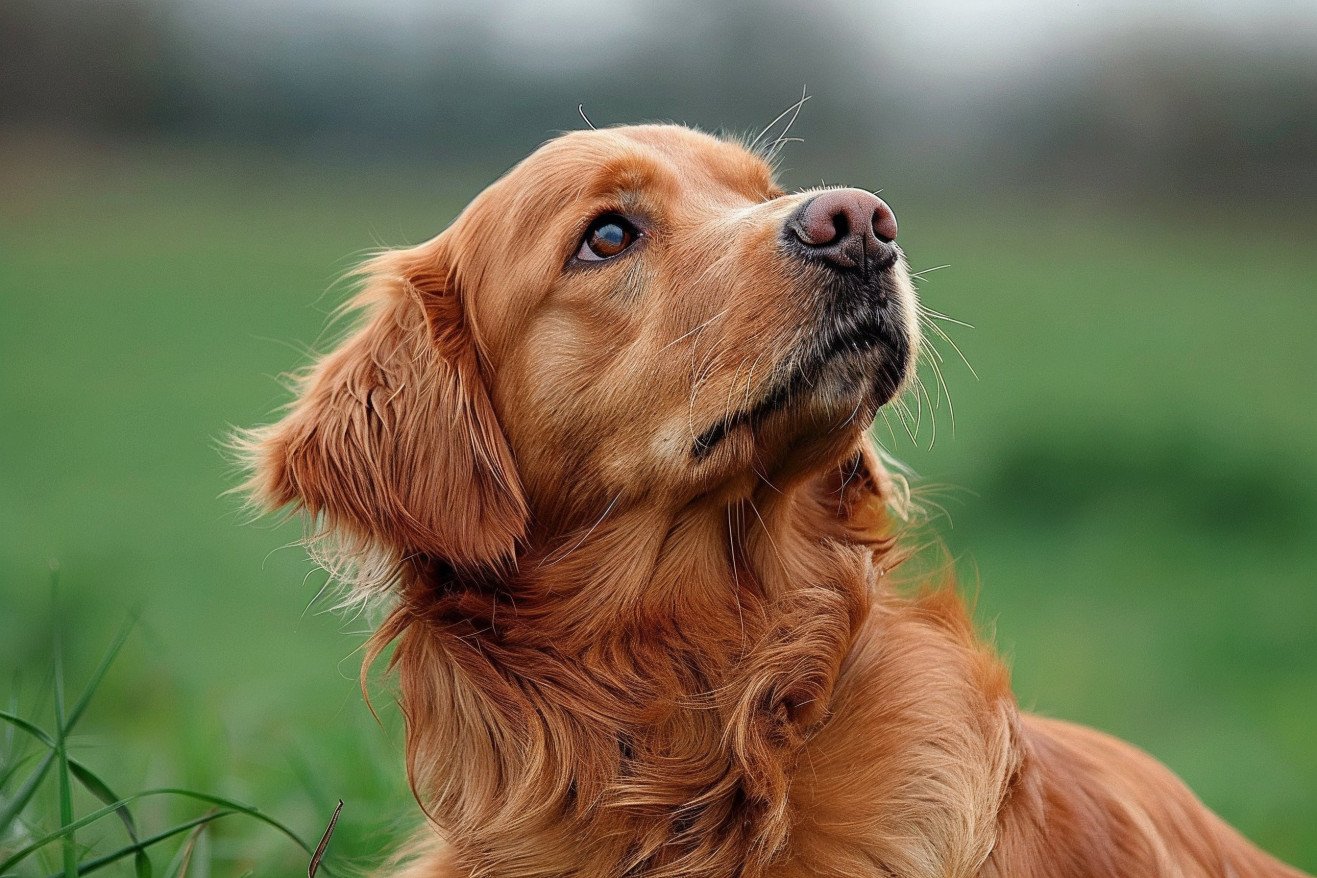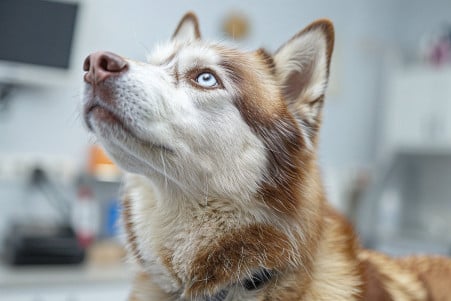Can Dogs Look Up? What to Know About Dog Vision and Neck Mobility
22 April 2024 • Updated 22 April 2024

If you’ve ever asked yourself, “Can dogs even look up?” you’re not alone. Many dog owners have wondered if their pets can physically look up or if the head tilt is just a cute quirk. The good news is that dogs can look up, and their eyes are positioned on the front of their heads, so they have a lot of upward range. However, dogs with brachycephalic skulls (like pugs and bulldogs) have a lot less range because of the shape of their faces.
We’ll go over what veterinarians and other animal experts have to say about how far dogs can really look up and how far they can move their necks. We’ll also talk about how dogs’ vision measures up to humans. By the end, you’ll have a better understanding of what your dog can see.
Can dogs look up?
Canine Cervical Spine and Neck Muscles: Anatomical Constraints
The cervical spine and neck muscles of dogs are anatomically specialized to limit extreme head tilting. The cervical vertebrae are characterized by a number of unique features, including triangular vertebral foramen, bifid spinous processes, and transverse foramina, which make the spine more flexible and less rigid. The atlas (C1) connects with the skull and the axis (C2) vertebra, and the odontoid process of the axis fits into the atlas, enabling rotation of the head while restricting its ability to tilt upward.
The primary function of the cervical spine is to support the head and protect the spinal cord, which is especially important given the vulnerability of the cervical spinal cord. As noted in Today's Veterinary Practice, in large dog breeds, spinal cord compression can occur due to conditions like Wobbler's syndrome, leading to a loss of mobility. In contrast to the longer neck muscles that enable rapid head movements in dogs, the neck muscles of humans are designed to enable the head to tilt upward more than it can in dogs.
This limited range of motion is reflected in the way dogs tilt their heads to the side to look up, rather than being able to look straight up. While the anatomical constraints of the cervical spine and neck muscles of dogs restrict their ability to look up, they also enable other behaviors, such as grooming and hunting. At the same time, these constraints also mean that dogs can't look straight up, which has implications for their ability to track objects in the sky. This knowledge of anatomical constraints helps to explain the natural head positions and behaviors of dogs.
Canine Visual System: Specializations and Constraints
The canine visual system is quite different from the human visual system in a number of ways. For example, while humans have binocular vision, dogs have monocular vision, which means that each eye sees a different image. This allows dogs to have a greater field of vision, but makes it more difficult for them to see things that are far away or above them. According to PetHelpful, this monocular vision is one of the reasons that dogs can't look up like humans.
The anatomy of the canine visual pathway is also unique. A study published in PMC used diffusion tensor imaging to trace the dog's optic nerve, chiasm, tracts, and cortical projections, including the helical Meyer's loop and Baum's loop. These structures are specialized to meet the dog's visual needs and the demands of its environment.
In addition, studies have shown that dogs have slower eye movements and longer fixations than humans. As explained in a PMC paper, dog saccades (rapid eye movements) never reach the peak velocities of human saccades, instead maintaining a lower speed for a longer period of time. This is likely a species-specific adaptation for the most efficient visual processing.
Dogs also have lower color discrimination and visual acuity than humans, which is why they rely more on their other senses, especially their sense of smell. This is even reflected in their response to being called from above, as their visual constraints make it more difficult for them to see things that are far away or above them. This is why dogs don't always look up when called from above. Knowing these specializations and constraints of the canine visual system can help us understand how dogs see and experience the world.
Sensory Compensation: The Amazing Olfactory Sense
Dogs' incredible sense of smell is one way that they compensate for their relatively poor vision. A study in the journal Animals found that dogs can detect odors at concentrations that are one million times lower than humans. This is the result of several anatomical and genetic adaptations, including a larger olfactory epithelium and more olfactory receptor genes than humans.
Dogs use their sense of smell to collect information about the world around them, identify people, and make choices. As ScienceDaily notes, the olfactory epithelium is folded and convoluted over bony turbinates in the nasal cavity, which increases the surface area and results in hundreds of millions more olfactory neurons than humans.
This amazing sense of smell has led to many real-world applications, with a study in BMC Infectious Diseases pointing out that dogs have been used to detect people with infectious diseases, cancer, and other illnesses based on the unique patterns of volatile organic compounds they give off. Dogs' sense of smell has also been used in law enforcement, search and rescue, and medical diagnosis.
The evolution of such a specialized olfactory system in dogs likely provided them with a great deal of benefits, helping to make up for their relatively poor vision and enabling them to succeed in their environments. This kind of multisensory integration is an important part of the dog experience and how dogs interact with the world.
Vision and Olfaction Integration: A Multisensory Process
Dogs use a combination of senses, especially vision and smell, to understand and interact with the world around them. According to Britannica, dogs have a wider field of vision than humans because their eyes are located on the sides of their heads, but they can't see as well up close or judge distances as well as humans. This monocular vision system works in tandem with their sense of smell, helping them pick up and follow scents while still being aware of their surroundings.
Dogs' sense of smell is also supported by the vomeronasal organ, or Jacobson's organ, which is a second olfactory system that's used for pheromone communication, according to VCA Animal Hospitals. This integration of vision and smell helps dogs build mental images from scents, which is an important part of their cognitive function.
Dogs use their multisensory skills in a number of real-world applications, including tracking, hunting, and working with humans in search and rescue and medical detection, as noted in a study published in ScienceDirect. More research on the ability of dogs to quantify multisensory cognition and emotions related to odors could lead to better training and uses for these amazing animals.
The Evolutionary Role of Olfaction in Mammals
The olfactory receptor gene family is the largest in the mammalian genome, accounting for 1% of all genes and enabling terrestrial vertebrates to detect millions of different odors. Research published in the American Journal of Physical Anthropology shows that this genetic expansion originated in reptiles around 200 million years ago. Mammals are the only animals to use an organ, the nose, to detect volatile odors, and nasal turbinates make retronasal olfaction possible, which is responsible for the complex olfactory experience.
The mammalian olfactory system is characterized by extensive genetic diversity, with the olfactory receptor gene family representing the largest gene family across all species. As the research explains, these genes are often found in subtelomeric regions of chromosomes, which makes it easier for them to duplicate and expand the olfactory receptor gene family through recombination. This genetic diversity is especially prevalent in humans, with genetic diversity found between populations that are geographically and culturally diverse, which may be the result of adaptive evolution of different olfactory functions.
The direct connection between the human olfactory system and the limbic system, which is responsible for emotion and memory, makes odors especially powerful. As the research notes, this extraordinary olfactory system provides important evolutionary benefits, adding to the extraordinary olfactory skills of other mammals, such as dogs.
Conclusion: Understanding and Accepting a Dog's World
Although dogs can look up, their ability to do so is limited by their unique anatomy and visual system. Dogs have a wider peripheral vision but a reduced ability to see in the distance and look up. Their limited neck movement and monocular vision, which means each eye sees a different image, means they can't look up as easily as humans.
Yet, dogs have evolved to rely on their sense of smell to make up for their visual limitations. Their large olfactory epithelium and specialized nasal passages enable them to detect scents at concentrations as low as parts per trillion, which gives them a rich experience of the world. This olfactory dominance, combined with their wider field of view, means dogs experience the world in a way that's fundamentally different from humans.
Recognizing these differences is important for understanding and accepting dogs and their behavior. It can also help improve training, communication between dogs and people, and the design of the environments we share with our pets. In the end, learning about the different ways animals experience the world can help us better understand and appreciate the diversity of life on Earth.


